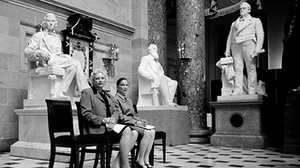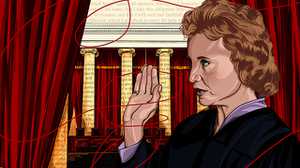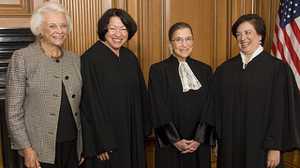Sandra Day O’Connor and the Reconsideration of Roe v. Wade
A legal journalist considers the intersection of abortion rights and the justice’s Supreme Court career.

By the time Sandra O’Connor came to the court in 1981, there was a fire raging about Roe v. Wade, which had been decided just eight years earlier. Now, why was that? My research tells me smart, strategic people around Richard Nixon in the Republican party thought, aha, we’ve had a really good run with the Southern strategy—to play the race card and peel the white Democrat voters in the South away and turn them into Republicans.
How about a Northern strategy? We’ve got a democratic party in the north filled with Catholic voters, urban, ethnic. We can inspire them to become Republicans if we go hot and heavy on abortion. Richard Nixon could not have cared less about abortion. The Republican party historically, for a number of years, had been the party of the equal rights amendment and of women’s reproductive rights.
What happened in the years after Roe was not a natural evolution, as many people think. It was cultivated. It was a party realignment that was carefully stage managed.
It wasn’t until 1980, with the platform that Reagan ran on seven years after Roe, that the [Republican] party said, we are committed to the right to life, and we’re committed to finding judges who will fully respect the right to life, which was code language for who would overturn Roe v. Wade. It was still incipient at the time that O’Connor arrived.
Akron v. Akron Center for Reproductive Health
Nobody knew what her views were, but the right to life crowd knew was she wasn’t marching along with them. So she got some frantically programmed questions at her Senate Judiciary Committee hearing, and she just played it very straight. She said at one point: I don’t support abortion; abortion is abhorrent to me, but I’m not a woman who’s about to get pregnant. So she really played it very smartly.
From her first several years on the court, one would have thought, here’s somebody that’s going to be a rock Republican conservative judge. She was way over on crime. She was very, very skeptical of affirmative action. She was skeptical of Roe v. Wade.
Her first public [Supreme Court] opinion on abortion came in the Akron case in 1983 [Akron v. Akron Center For Reproductive Health]. She had been on the court for two years. The Akron case served up to the court a series of abortion restrictions that really challenged Roe v. Wade [including requirements for: all abortions performed after the first trimester to be done in hospitals, parental consent before the procedure could be performed on an unmarried minor, doctors to counsel prospective patients, a 24 hour waiting period and that fetal remains be disposed of in a "humane and sanitary manner."]. The court reaffirmed Roe, and O’Connor dissented, [saying, “I believe that the State's interest in protecting potential human life exists throughout the pregnancy.”]
It was obvious there were four justices opposed to that, and there were four justices fully for that. And everybody assumed that O’Connor was going to be also fully for undercutting Roe. But she wouldn’t go along. She wrote a separate opinion, deciding the case very narrowly. She said there may be time in the future to deal with the bigger, deeper issue, but that time has not arrived.
Planned Parenthood v. Casey
In 1992, it really did look as if the court was about to overturn Roe v. Wade, because Justice Brennan had retired, replaced by Justice Souter. Thurgood Marshall had retired, replaced by Clarence Thomas. There was no longer the original Roe v. Wade majority. They were gone.
So the case came to the court. Like all of these cases, it came as a set of restrictions that, in this case, the state of Pennsylvania had imposed on access to abortion. But there was a real effort, actually by the pro-choice side to get the court to focus on the big issue. Why? Because 1992 was a presidential election year, and President Bush was running for reelection against Bill Clinton. The pro-choice side thought, okay, if in June of 1992, in this Casey case, Roe v. Wade is overturned, we’ll have one hell of an election issue.
It’s not that [the pro-choice side] wanted it to be overturned. They were afraid it was going to be overturned in the quite immediate future. And so, if that was going to happen, let it happen when the election in 1992 could become a public referendum. So there was just a lot of noise surrounding this Casey case. The case was argued in April of ’92. And from the argument, things were not looking very good for the pro-choice side.
Last day of the term in June of ’92, everybody troops up to the Supreme Court. Usually, you don’t know when a Supreme Court decision is coming, but it was the last day of the term, and Casey was the last undecided case, so everybody knew this was the day. I mean, I remember going into the courtroom thinking, okay, you know, I’ve been writing about this issue for 20 years, and now it’s going to be over?
But famously, three Republican-appointed justices, Justice O’Connor, Justice Kennedy and Justice Souter, held the balance of power in the case. They were joined on the left by Justice Stevens and Justice Blackman. And they reaffirmed the right to abortion. They didn’t reaffirm Roe v. Wade, per se. They changed the standard to a standard that O’Connor had been advocating for some years, the undue burden standard. If there’s a restriction that has the purpose or effect of cutting off a woman’s access to abortion, that burden is undue.
O’Connor-ism
It was an example, really, of kind of O’Connor-ism in a sense of we can do what makes us feel comfortable. There are things we don’t like about Roe v. Wade, but there’s things we really don’t like about just getting rid of it. And so this is what we’re coming out with. And this is what has basically held since 1992.
Her strength as a justice was not to be swayed by the rhetorical dressing that cases often come in, one side or the other side. She looked beyond the rhetoric for the facts that would indicate how the case should be decided as a dispute, not as a billboard, not as a voice of the ages. We’ve got a dispute before us. We’re going to solve it. We’re going to not necessarily settle it. We’re going to solve this case. I think that was her strength, and it’s not all that common on the court.
Our interview with Linda Greenhouse has been edited for clarity. Greenhouse is a New York Times contributor and co-author of The Burger Court and the Rise of the Judicial Right.







